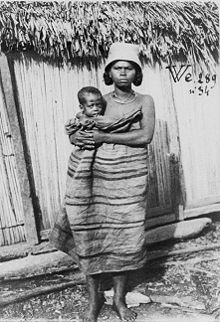Tanala
 Tanala woman and child | |
| Regions with significant populations | |
|---|---|
| Madagascar | |
| Languages | |
| Malagasy | |
| Related ethnic groups | |
| Other Malagasy groups; Austronesian peoples |
The Tanala are a Malagasy ethnic group that inhabit a forested inland region of south-east Madagascar near Manakara. Their name means "people of the forest." Tanala people identify with one of two sub-groups: the southern Ikongo group, who managed to remain independent in the face of the expanding Kingdom of Imerina in the 19th century, or the northern Menabe group, who submitted to Merina rule.
The Tanala speak a dialect of the Malagasy language, which is a branch of the Malayo-Polynesian language group derived from the Barito languages, spoken in southern Borneo. Among the Tanala it is traditional to keep the body of a deceased individual for a month or more; the dead are then buried in the forest in coffins carved from large logs, with sacrifices to mark the cutting of the log and indications carved into a tree to indicate the location of the burial.
Ethnic identity

The Tanala are a Malagasy ethnic group that inhabit a forested inland region of south-east Madagascar near Manakara.[1] In 2013, the Tanala numbered around 400,000 people.[2] Their name means "people of the forest."[1] Several Tanala rulers trace their lineage back to Antaimoro ombiasy (wisemen) who migrated to the area after 1550.[3] Tanala people identify with one of two sub-groups: the southern Ikongo group, who managed to remain independent in the face of the expanding Kingdom of Imerina in the 19th century, or the northern Menabe group, who submitted to Merina rule.[3] Recently, researchers have suggested that the Tanala are not truly a separate ethnic group.[3]
History
Several Tanala rulers trace their lineage back to Antaimoro ombiasy (wisemen) who migrated to the area after 1550.[4] In the 18th century the Tanala led a bloody conquest of the eastern coast.[5] In the 18th century the Tanala led a bloody conquest of the eastern coast.[3]
Culture
Traditionally, all Tanala men and women regardless of social class wore clothing made from woven or beaten mats made from harefo reeds (Eleocharis plantagines). Mat clothing (tafitsihy) for women consisted of several rectangular pieces stitched together into a tube that was worn drawn up at the shoulder or belted at the waist, while men wore a beaten bark loincloth and a mat jacket or tunic with longer sleeves for older men.[6]
Funeral rites
Among the Tanala it is traditional to keep the body of a deceased individual for a month or more; the dead are then buried in the forest in coffins carved from large logs, with sacrifices to mark the cutting of the log and indications carved into a tree to indicate the location of the burial.[3]
Language
The Tanala speak a dialect of the Malagasy language, which is a branch of the Malayo-Polynesian language group derived from the Barito languages, spoken in southern Borneo.
Economy
Their major crops are coffee and rice.[3]
Notes
- ^ a b Bradt & Austin 2007, p. 28.
- ^ Diagram Group 2013.
- ^ a b c d e f Bradt & Austin 2007, p. 29.
- ^ Ogot 1992, p. 855.
- ^ Ogot 1992, p. 880.
- ^ Condra 2013, p. 456.
Bibliography
- Bradt, Hilary; Austin, Daniel (2007). Madagascar (9th ed.). Guilford, CT: The Globe Pequot Press Inc. pp. 113–115. ISBN 1-84162-197-8.
{{cite book}}: Invalid|ref=harv(help) - Condra, Jill (2013). Encyclopedia of National Dress: Traditional Clothing Around the World. Los Angeles: ABC Clio. ISBN 978-0-313-37637-5.
{{cite book}}: Invalid|ref=harv(help) - Diagram Group (2013). Encyclopedia of African Peoples. San Francisco, CA: Routledge. ISBN 9781135963415.
{{cite book}}: Invalid|ref=harv(help) - Ogot, Bethwell A. (1992). Africa from the Sixteenth to the Eighteenth Century. Paris: UNESCO. ISBN 9789231017117.
{{cite book}}: Invalid|ref=harv(help)
